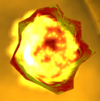Wormhole: Difference between revisions
(Obstructed wormholes.) |
|||
| (8 intermediate revisions by 2 users not shown) | |||
| Line 1: | Line 1: | ||
[[File:WormholeNetwork.png|thumb|right|Interstellar wormhole network.]] | [[File:WormholeNetwork.png|thumb|right|Interstellar wormhole network.]] | ||
'''Wormholes''' are portals that connect solar systems and galaxies. Spacecraft can utilize them to instantly travel between solar systems. | |||
A wormhole can also become ''obstructed'' by a celestial body that orbits across it. If a spacecraft emerges from a wormhole like that, the spacecraft is placed farther away from the destination sun until it doesn't hit anything. Crew will not attempt to enter a wormhole that is obstructed by a celestial body. | |||
[[Starship]]s use [[Wormhole_Drive|wormhole drive]]s to travel instantly from one [[Solar_System|solar system]] to another through interstellar wormholes. Starships also use wormhole drives to travel instantly from one galaxy to another through intergalactic wormholes. | |||
==Wormhole Types== | |||
There are three types of wormholes: | |||
[[ | ===Interstellar Wormholes=== | ||
Interstellar wormholes form naturally in the universe and interconnect [[Solar_System|solar system]]s in a loose branching network. Almost every solar system has one or more interstellar wormholes near the primary [[sun]]. Not all solar systems are interconnected by wormholes. Wormholes can create disjoint islands of interconnected solar systems. | |||
Interstellar wormholes form at their origin star with a positive polarity and then end at a random destination star within a 3[[pc]] range negative polarity. | |||
{| | {| | ||
| [[File:WormholeInterstellarPositive.png|thumb|100px | | [[File:WormholeInterstellarPositive.png|thumb|none|100px|Interstellar positive wormhole.]] | ||
| [[File:WormholeInterstellarNegative.png|thumb|100px | | [[File:WormholeInterstellarNegative.png|thumb|none|100px|Interstellar negative wormhole.]] | ||
|} | |} | ||
== | ===Artificial Wormholes=== | ||
[[Ringworld#Star_Gate|Star gate]]s can create temporary artificial wormholes to a destination [[Solar_System|solar system]] from which a [[preon]] was harvested. The destination system of a star gate could even be in another galaxy, which of course requires that the preon is from a star in that galaxy. | |||
{| | |||
| [[File:WormholeArtificialPositive.png|thumb|none|100px|Artificial positive wormhole.]] | |||
| [[File:WormholeArtificialNegative.png|thumb|none|100px|Artificial negative wormhole.]] | |||
|} | |||
===Intergalactic Wormholes=== | |||
Intergalactic wormholes are special in that they are one-way wormholes to another [[galaxy]], they have a neutral polarity since they have no exit at the destination. They can be found at [[Black_Hole_(Celestial)|celestial black holes]] and at each galaxy's [[Supermassive_Black_Hole|supermassive black hole]]. Intergalactic wormholes at a supermassive black hole can be considered two-way, since they always have a wormhole leading both ways. | |||
The exit point of a celestial black hole's intergalactic wormhole will be located at a relative location in the destination galaxy. The size of the origin galaxy and destination galaxies are used to scale the distance from the galaxy's core, traveling to a galaxy that is 50% the size will result in being being 50% closer to the core. | |||
[[File:WormholeIntergalacticNeutral.png|thumb|none|100px|Intergalactic neutral wormhole.]] | |||
==Polarity== | |||
Each end of an interstellar wormhole has its own polarity, one end of the wormhole will have a positive polarity, the other end of the wormhole will have a negative polarity. | |||
Intergalactic wormholes are always neutral | Intergalactic wormholes are '''always''' neutral. | ||
The polarity of a wormhole can be identified by its color: | The polarity of a wormhole can be identified by its color: | ||
| Line 39: | Line 43: | ||
* '''Negative''' wormholes are identified by red, yellow and white colors. | * '''Negative''' wormholes are identified by red, yellow and white colors. | ||
* '''Neutral''' wormholes are identified by blue and magenta colors. | * '''Neutral''' wormholes are identified by blue and magenta colors. | ||
[[Category:Science]] | [[Category:Science]] | ||
Latest revision as of 20:34, 14 April 2024

Wormholes are portals that connect solar systems and galaxies. Spacecraft can utilize them to instantly travel between solar systems.
A wormhole can also become obstructed by a celestial body that orbits across it. If a spacecraft emerges from a wormhole like that, the spacecraft is placed farther away from the destination sun until it doesn't hit anything. Crew will not attempt to enter a wormhole that is obstructed by a celestial body.
Starships use wormhole drives to travel instantly from one solar system to another through interstellar wormholes. Starships also use wormhole drives to travel instantly from one galaxy to another through intergalactic wormholes.
Wormhole Types
There are three types of wormholes:
Interstellar Wormholes
Interstellar wormholes form naturally in the universe and interconnect solar systems in a loose branching network. Almost every solar system has one or more interstellar wormholes near the primary sun. Not all solar systems are interconnected by wormholes. Wormholes can create disjoint islands of interconnected solar systems.
Interstellar wormholes form at their origin star with a positive polarity and then end at a random destination star within a 3pc range negative polarity.
 |
 |
Artificial Wormholes
Star gates can create temporary artificial wormholes to a destination solar system from which a preon was harvested. The destination system of a star gate could even be in another galaxy, which of course requires that the preon is from a star in that galaxy.
 |
 |
Intergalactic Wormholes
Intergalactic wormholes are special in that they are one-way wormholes to another galaxy, they have a neutral polarity since they have no exit at the destination. They can be found at celestial black holes and at each galaxy's supermassive black hole. Intergalactic wormholes at a supermassive black hole can be considered two-way, since they always have a wormhole leading both ways.
The exit point of a celestial black hole's intergalactic wormhole will be located at a relative location in the destination galaxy. The size of the origin galaxy and destination galaxies are used to scale the distance from the galaxy's core, traveling to a galaxy that is 50% the size will result in being being 50% closer to the core.

Polarity
Each end of an interstellar wormhole has its own polarity, one end of the wormhole will have a positive polarity, the other end of the wormhole will have a negative polarity.
Intergalactic wormholes are always neutral.
The polarity of a wormhole can be identified by its color:
- Positive wormholes are identified by blue, cyan and white colors.
- Negative wormholes are identified by red, yellow and white colors.
- Neutral wormholes are identified by blue and magenta colors.